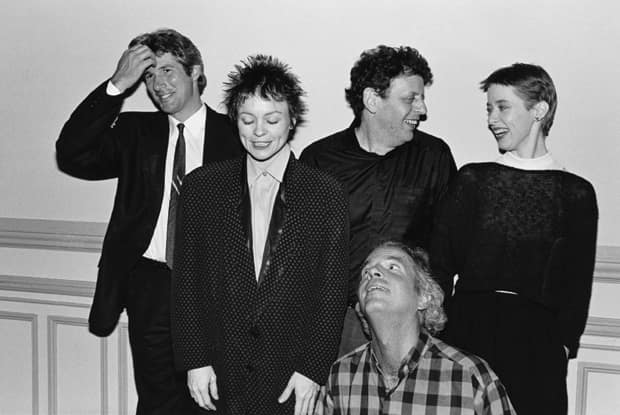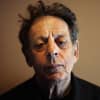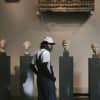 Over the course of his decades-long career, Philip Glass has cast a wide net of friends and collaborators. From his start as the art world’s musical darling, composing minimalist works in lofts in the ’70s, to his breakout as a widely recognized composer of avant-garde operas, symphonies and major motion picture film scores, Glass has remained a genre agnostic, faithful only to notes on the page and an uncompromising work ethic. We talked to a number of Glass’ contemporaries and collaborators about his sizeable output. Together they weave a portrait of the most famous outsider composer living today.
Over the course of his decades-long career, Philip Glass has cast a wide net of friends and collaborators. From his start as the art world’s musical darling, composing minimalist works in lofts in the ’70s, to his breakout as a widely recognized composer of avant-garde operas, symphonies and major motion picture film scores, Glass has remained a genre agnostic, faithful only to notes on the page and an uncompromising work ethic. We talked to a number of Glass’ contemporaries and collaborators about his sizeable output. Together they weave a portrait of the most famous outsider composer living today.
CHUCK CLOSE (Artist): I met Phil in 1964 when Richard Serra and Nancy Graves were living in Paris. I had a Fulbright to Vienna and I came over to visit them. He was studying with the great composer Nadia Boulanger. [Back in New York] we were constantly in someone’s loft, seeing either dance or a performance piece or music. I think the first score I heard was sort of the precursor to Music in Changing Parts. Experiments working towards that. We’d lie on our backs on the floor of someone’s loft and listen to the music. Of course, the music establishment had no interest in Phil whatsoever, so all his first performances were in art galleries like Paula Cooper, and the first performances outside of an individual loft were in museums. Visual artists really were his real supporters.
Phil was [Serra’s] first and only paid assistant. Phil was doing plumbing, and he plumbed two lofts for me—one on Greene Street and one on Prince Street. I think about the stuff that we used to move—you know, lead sculptures and stuff like that, and trying to get them up flights of stairs, and that Phil’s hands were at risk like that was amazing. Richard needed lots of bodies to help make his pieces, and so the rest of us worked to help him make these things, and it was really quite dangerous. I mean, I almost became a quadriplegic before I became a quadriplegic, when I was inside the original One Ton Prop (House of Cards), which is one ton of lead, and they just pulled me up out of it with a block and tackle and we were standing looking at it and the whole thing fell down. Richard was smart enough not to have other sculptors work for him. We could all expand his ideas without feeling like he was ripping us off.
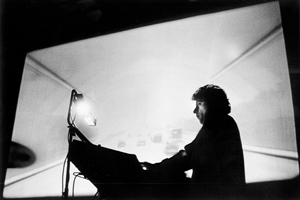
LUCINDA CHILDS (Choreographer): In the ’70s, I’d gone to the lofts, listening to Philip and other musicians for hours and hours. I thought it was beautiful, the way Philip conducts. He sort of nods, and that means that they’re moving on to another figure. Their sheet music was not bound at the time, so they very often just tossed the page off the music rack and music ended up all over the floor at the end of the evening. I didn’t think about dancing to it because it was in and of itself so powerful, just to be there and listen.
 DAVID HARRINGTON (Violinist and founder of Kronos Quartet): One of the great things about working with Philip is that he’s not possessive about his music. Occasionally you run into someone who thinks their music can only be done in one way, and really believes in their notation and the sanctity of the way it’s been presented to us. Philip isn’t that way at all. There’s an openness to interpretation and experimentation that, to me, is really collaborative. As a performer, you feel very invested in the end result. You can put everything you know about music into his work and feel like you can be learning new things. It’s hard to describe it, but it’s partly a personality thing. He’s very comfortable in the musical situation of rehearsing and concerts. That’s another really important thing about him as a performer/composer: he knows what it feels like to be on the stage.
DAVID HARRINGTON (Violinist and founder of Kronos Quartet): One of the great things about working with Philip is that he’s not possessive about his music. Occasionally you run into someone who thinks their music can only be done in one way, and really believes in their notation and the sanctity of the way it’s been presented to us. Philip isn’t that way at all. There’s an openness to interpretation and experimentation that, to me, is really collaborative. As a performer, you feel very invested in the end result. You can put everything you know about music into his work and feel like you can be learning new things. It’s hard to describe it, but it’s partly a personality thing. He’s very comfortable in the musical situation of rehearsing and concerts. That’s another really important thing about him as a performer/composer: he knows what it feels like to be on the stage.
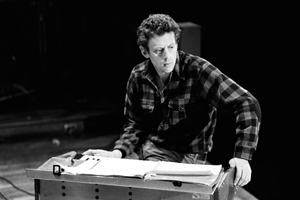 RIESMAN: I started working with Philip Glass basically because I found myself in the right place at the right time. It was 1974. I was an academic as of 1972 to ’73, where I was teaching at the State University of New York in Purchase. I wanted to get out of that world. I’d been hanging out in clubs, playing soft rock piano and doing some solo improvised piano concerts in some galleries downtown, trying to figure out what I wanted to do with my life. I met Philip through an artist friend before I had gotten to know his music. He took me to a Philip Glass concert where I heard the premiere of Music in Twelve Parts at Town Hall in 1973. It just so happened that his keyboard player—a guy named Bob Telson—had to leave. I had just given a concert at 112 Greene Street and one of the guys in Philip’s band, the saxophone player Dickie Landry, had heard my concert and the band was discussing, “Well, who do we know who’s been on the scene that might be the right person to play keyboards?” He said, “Why don’t we check out this guy Riesman?” I got an invitation to come and audition with Philip for an upcoming tour in the fall of 1974. That was the start, and I’ve been with him ever since.
RIESMAN: I started working with Philip Glass basically because I found myself in the right place at the right time. It was 1974. I was an academic as of 1972 to ’73, where I was teaching at the State University of New York in Purchase. I wanted to get out of that world. I’d been hanging out in clubs, playing soft rock piano and doing some solo improvised piano concerts in some galleries downtown, trying to figure out what I wanted to do with my life. I met Philip through an artist friend before I had gotten to know his music. He took me to a Philip Glass concert where I heard the premiere of Music in Twelve Parts at Town Hall in 1973. It just so happened that his keyboard player—a guy named Bob Telson—had to leave. I had just given a concert at 112 Greene Street and one of the guys in Philip’s band, the saxophone player Dickie Landry, had heard my concert and the band was discussing, “Well, who do we know who’s been on the scene that might be the right person to play keyboards?” He said, “Why don’t we check out this guy Riesman?” I got an invitation to come and audition with Philip for an upcoming tour in the fall of 1974. That was the start, and I’ve been with him ever since.
ALAN VEGA (One half of the '70s electronic duo Suicide): I saw him live at the Leo Castelli Gallery, sometime in the early ’70s. He just came down from uptown and was showing his art there, and playing as well. I know Marty [Martin Rev, keyboardist in Suicide] was there with me. We sat down, everybody sat down—there were a lot of people there—and after about 45 minutes Marty says, “Well, why don’t we just get out of here.” He started by playing solo, maybe two or three other people playing the same thing. He made only one note change in the whole thing. We knew which way it was going, we understood. The floor was very creaky, so Marty and I were crawling out from our positions. We had to crawl out from the creaks and it was embarrassing.
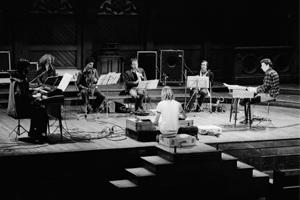
RIESMAN: There was a core of devoted fans that just loved what we were doing and thought it was the greatest thing. We were better known in Europe at the time. The first tour I did with Philip—that very first tour in 1974—we went to Berlin, Paris and Rome. At the same time, Philip has always had his detractors and we had some priceless reviews from the early years, headlines like “Glass Invents New Sonic Torture.” Some people hated it. There were sometimes violent reactions in the concerts. Somebody would just walk onstage and start screaming, “That’s not music!” or something.
NICO MUHLY (Composer and former assistant): There are a lot of problems with repetitive music because players don’t know how to play it. Repeated patterns—classical musicians are such a pain in the ass with that stuff. Even the best, best, best ones will be like, I don’t want to play that all night. If you look at like any guitar player who has to play the same thing all evening, it’s like, Shut up! It’s interesting because you’re not used to playing two notes forever. It’s a different kind of sensibility. It’s like one of those memory games where you add a gesture, and it always has to have that air of—not improvisation, but natural unfolding. A good example is part four of Music in Twelve Parts, where, at 12 minutes, the bass comes in and you’re like, Aha! Just revelatory moments where, if it had come in sooner, it would be like...oh. It’s using time as an element of composition. Where, instead of thinking about things like moment to moment drama, you’re thinking of this bigger time scale. If you listen to a late romantic symphony, it’s like a fast footprint, that doesn’t mean how fast the notes are going—even in the slow music it’s just shifting around—and in Philip’s stuff, the harmonic footprint is glacial. It’s basically like watching something happen very slowly. It’s time-lapse, essentially.
ERROL MORRIS (Filmmaker): I really bristle at people who say that Philip only writes one kind of music or one kind of thing. Philip says he really objected to being called a minimalist, and once an interviewer looked at him and said, “How about I just call you a New Age composer?” And Philip looked at them and said, “Minimalism will be fine.”
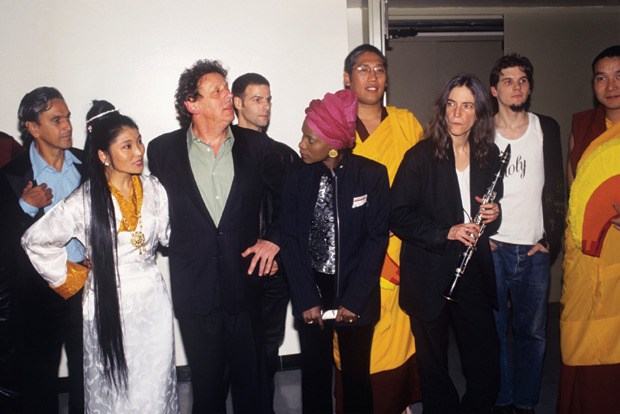
Above Photography: Lynn Goldsmith/CORBIS, Philippe Gras, Theo Audenaerd/Hollandse Hoogte/Redux, Michael Grecco, Ebet Roberts.
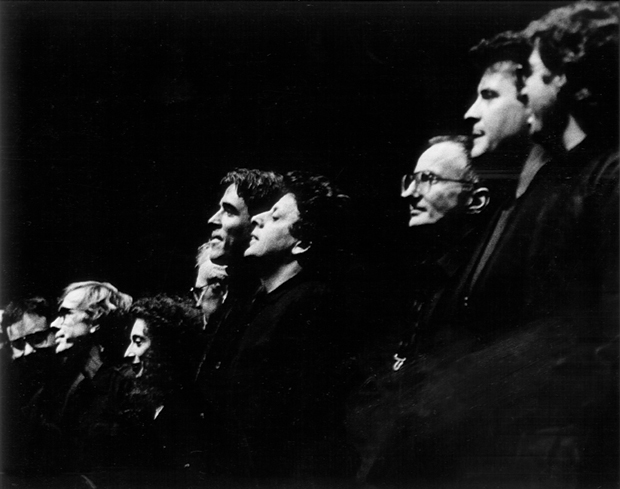
CLOSE: The collaboration with [Robert] Wilson marked the beginning of [Glass’ many] collaborations. This is the first time that he began to work with choreographers, and work with singers. Wilson contributed most of the visual stuff, although I think Phil did as well, and it rewrote opera as we knew it. He was using cheap, tinny electric pianos—the cheaper the better, the tinnier the better. He doesn’t like to be called “minimalist,” but they were extremely reductive in nature, those pieces. You know, ABCDEFG 12345678910 were the lyrics, and that sort of minimal, non-traditional opera dialogue—if you ever saw the libretto for one of Phil’s operas, it’s hilarious. Nobody had ever seen anything like it. Steve Reich was doing a lot of stuff with tape loops, so things would go in and out of phase, because they were tape loops overlaid on top of each other. But [Glass] taught his musicians to go in and out of phase by actually counting, which is very, very different. But what happened was, he got overtones, and out of the overtones he got fugue-like complexity, six or seven notes. That was an amazing breakthrough for music, I think.
CHILDS: During the first run of Einstein on the Beach, I was on stage for about three hours. I did my own solo in the first act and then I was onstage for a great deal of the second and third acts. The audience would leave and come back. They couldn’t sit that long. They just needed to get up and get some air and come back. In the original version, which is about five hours, the five “Knee Plays,” which I performed with Sheryl Sutton, tended to be a time when people felt, Oh, this is a break. But that became less and less the case, especially when we did the revivals in ’84 and ’92. In fact, in ’92, with the slightly shorter version, which is more like three and half hours, people didn’t move at all.
JASPER MCGRUDER (Actor and performer in Einstein on the Beach): Einstein on the Beach really just filled you in a very quiet and subtle kind of way which lent itself to the beauty of love, and finding it and touching it and really letting it embrace you. There’s a sense memory that comes with those musical moments. I think that the performers and the audience go home with the same thing. Because, time-wise, it’s unlike a lot of other works. And to sit there for five, six hours, it is quite a ride and you are very full after it—it really is an experience. It’s unlike a lot of artistic ventures out there and it is seminal and very unique in that way. It really is creating a whole new world for people.
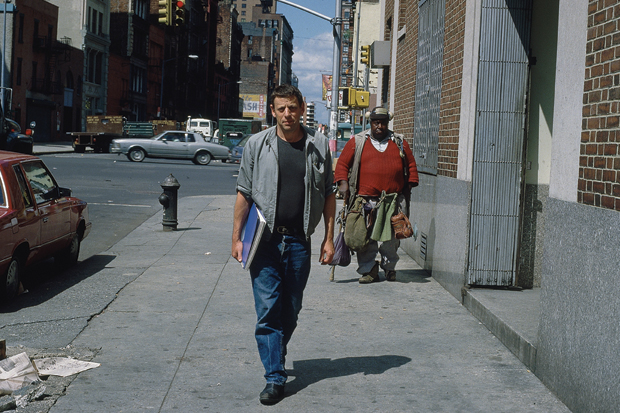
CLOSE: As contributors to Einstein on the Beach, we got box seats to watch the thing, and it was an absolutely amazing experience. Remember Sesame Street in the early years? Mr. Hooper’s Store was part of Sesame Street, and I was in a box with Mr. Hooper, which was pretty funny, because he said to his wife, who had dragged him there—he said, “What is this shit? Are you fucking kidding me? Do I have to sit and listen to this?” And he got up and left. I did get an autograph from Mr. Hooper to give to my daughter.
Right after the premiere, which attracted a great deal of attention but no money, [Glass] was driving his cab, and an elderly patrician lady climbs into the backseat of his cab, and she was reading his cab license. She saw his name, and she said, “Young man, do you know you have the same name as the composer?” And Phil didn’t even tell her.
RIESMAN: I remember very vividly, still in the ’70s, doing a piece called Dance in Torino, Italy, and the reaction to the second movement, which is very severe—just a solo organ, a solo dancer, the same thing going on and on. There was a near riot in the audience behind me and I got scared to the point where I had one of the sound guys come and just stand next to me during that movement. There were the detractors and the enthusiasts each shouting at each other trying to drown each other out. The detractors shouting, “Basta! Basta!” meaning “enough” in Italian, and the other ones shouting “Bravi! Bravi!” meaning “great.” We were doing something radical, and that’s the kind of reaction you would expect.
CHILDS: Dance was controversial. The dance audience was really quite shocked. We had wanted to involve a visual artist because we wanted it to be a collaboration on a similar scale to Einstein. Philip had the idea to talk to Sol LeWitt. Sol was a friend of Philip’s, and Philip felt that Sol was someone who took interest in different artists and different art forms, not just his own. Immediately Sol said, “I’m not interested in making something traditional. Making a drop that you dance in front of makes absolutely no sense to me, because what you’re doing is visually very complex anyway, and I don’t want to add to that or just put something arbitrarily there for the sake of having decor.” That’s how we came up with the idea that the decor could be the dancers and that the dancers could be on film. Dance is the only time Sol ever did this kind of film or a piece for theater.
Above Photography: Theo Audenaerd/Hollandse Hoogte/Redux, Ted Thai/Time & Life Pictures/Getty Images.
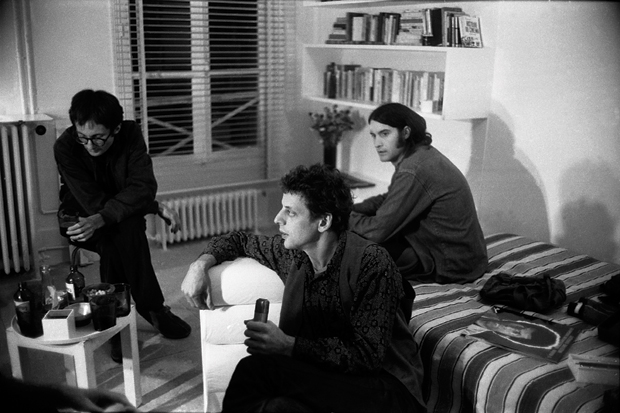
GODFREY REGGIO (Filmmaker): I’ve never looked at [Glass’] music as minimalist. I don’t like that term. I think it’s a term developed for those that didn’t understand what was happening with that whole movement of music. To me it’s metamorphic music, which is completely different than minimalist. It’s constantly changing and ascending and never reaching the top. It’s like life itself. It’s constantly ascending but never reaching because life is a circle. So it’s completely circular music that opens up the heart to another point of view. What I love about music is that it has a different response for different people. If there were a hundred people listening to it, and they all had the same response, it wouldn’t be so interesting. When I chose a composer to start working with almost 35 years ago, I was looking for someone whose music didn’t tell you what to feel or think or do. I wanted music that—I hate to use the word, but let me use it—had a spiritual language to it. And I found that Philip, in fact, has created a musical language of his own which moved me deeply. It was not the 12-tone Western scale, which he studied. I’m not an expert at it, but I would say it comes more out of the tradition of Vedic Hindu chant, of something that is actually quite close to jazz but in a more ritualized form. In film, emotion is at the top tier, beyond technique. Technique’s at the service of emotion. Music portends a direct transmission to the soul of the listener. So all of that, he gets a view of and then he starts writing where he’s motivated to go.
MORRIS: He’s an anti-film-composer composer, which makes him a really great film composer. There’s a whole idea of film composition that somehow you’re supposed to score to picture. You’re supposed to underline the drama of a particular scene, reference it, accentuate it. The music serves as dramatic underlining for material that is already there. One of the things that’s fascinating about Philip’s music, at least in my work, is it doesn’t comment on the action. But my movies are really hard to write music for. If you’re writing a score for say, Koyaanisqatsi, Powaqqatsi, or for a traditionally dramatic scene with actors, it’s very different than when you have to write music for these stretches of people talking. It is operatic because you’re writing a line for a single person. It provides a strange kind of metaphysical underpinning to what is going on. It’s a different idea about the use of music in pictures.
When I was editing The Thin Blue Line, I had always imagined that there would be re-enactments. I put Glassworks against them, and it was extraordinary. It was just absolutely clear. Then the problem became, do I get someone to write a Philip Glass-like score, or do I get Philip Glass? He was not terribly interested. I had a really hard time getting him to look at a rough cut of The Thin Blue Line. It took months and months and months. I finally got him to a screening and immediately after the screening he said he was writing the music. After he saw it, there was never any question at all. Philip wrote a lot of music for the movie and it was great, but it didn’t work. And I thought, Oh no. What am I going to do? And then suddenly I realized, well wait a second, what if I just switch the music around? What if I just put the cues where I want to put them instead of where he had intended to put them? What if I leave off two measures of ostinato at the very beginning? What then? And as I started to work with the music, it was clear that a lot of it was really, really good. Additional material had to be written and we would argue about it. Philip can be difficult, but he has never, ever failed to work with me. He’ll complain about me, but in the end he will always create a great score. Philip has told me that it’s one of the pieces of music that he’s most proud of.
HARRINGTON: We had so much fun doing the Dracula soundtrack together. There are certain moments in there that are just vintage Philip Glass. It’s so beautiful, and the rhythms and the harmonies and the propulsion that it gives are fantastic. The original version basically didn’t have a soundtrack, and I think it achieved a status in the culture that is quite distinct. It was a pretty gutsy idea to try to make a soundtrack to that film, but I think what happens is you really feel that the music in that film has united things in a new way. There’s a bit of Wagner in the original, he included that in the soundtrack and the way he does it is so perfect. I can’t imagine the film without that music.
RIESMAN: When it came to doing the live score of Dracula, Kronos said, Well we can’t really do it live, it’s too demanding to do the whole thing just nonstop like that. And also, how would they stay in sync with the picture? So Philip came up with the idea that he’ll arrange one-and-a-half piano parts for him to play, and me to play one handed and occasionally two handed, and be able to conduct with my other hand. Basically, pianos would take over a lot of the arpeggios and busywork that’s involved, and the strings could play more lyrical parts and not have to work so hard.
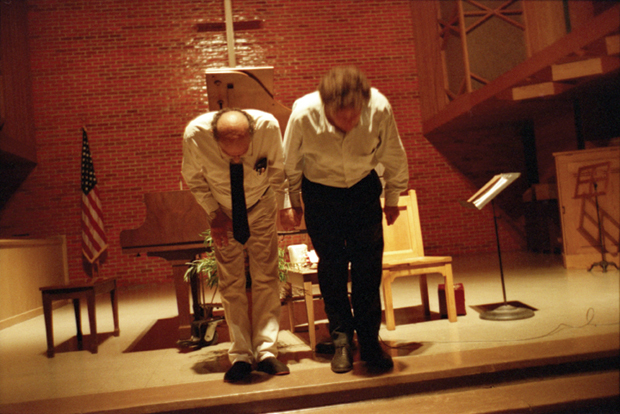
PAUL SCHRADER (Filmmaker): Because Mishima was such a puzzle box of things, I was looking for a unifying principle, and I thought that might be music. Somebody suggested Phil, so I approached him and told him, “You make the river, I’ll make the boat. The river will flow from the first frame to the end and will carry our boats with it.” Philip read the script, read the novels, biographies, came to the set—we were in Tokyo—but he did the score without seeing the film. He did a kind of 40-minute opera piece based on the books and on the script. From there, I had this piece of music which was roughly analogous to the script. Then I had to edit the film, so I kept changing the music—doubling it, repeating it, editing it so it all fit. Then I played it for Phil and I said, “Well, I really messed up your music here, but now it all fits—all the sync-points are right, the click track is right.” So he listened to it, understood, then went back and wrote a second score. The first one was done as an inspiration, the second one was done as a synchronized task. His first score was synth, the second score we did with an orchestra. The Kronos Quartet did all the string parts, but it was also orchestral. That score has become so famous—you hear it in elevators. Also, you hear it in other movies. Because we couldn’t pay Phil what he deserved, he retained the rights to the score. When you hear Mishima in another movie or in a commercial or something—and you do hear it—it’s a theatrical score. There’s no way we could have paid him what he would have merited. The weirdest place I’ve ever heard the score was in Walmart.
SUZANNE VEGA (Musician): When I heard the Mishima album, I asked [Glass] if he was trying to express anything emotionally. He said no. It was just his work that he was doing. One time he was talking to me about a Paul Simon song and he said, “Can you imagine that Paul Simon wrote a song about a photograph, and it was about a real photograph that he actually had?” I was like, But Phil, that’s the way most songwriters write, about personal things in their personal lives. That’s what most people do.
CLOSE: Phil was married to a woman [Luba Burtyk] who was a physician. She was from somewhere in Eastern Europe—Romania, Bulgaria, something like that—and her mother came over to visit. So Phil’s wife took her to the Whitney, and she showed her the painting I did of Phil. And she said, “Oh, your husband must be very powerful and famous,” and she said, “Well he’s a very well-known, very respected composer.” She said, “No, no—really powerful and famous.” She had never seen an image of anyone’s face that big that wasn’t one of those huge Eastern Bloc Soviet images of Lenin that are five stories high. The assumption was that he was politically powerful and politically important and not important as a composer. I sort of liked that idea because he was anything but well-connected, powerful or whatever when I painted him; it really made her mother’s day.
Above Photography: Phillipe Gras, Nubar Alexanian.
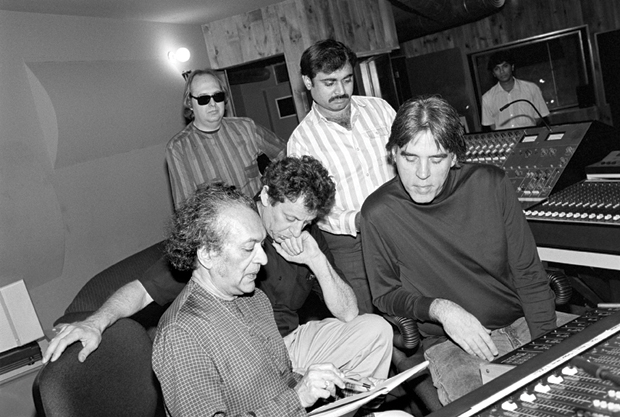
MUHLY: Philip is one of the very few classical composers who has anything like employees, which is a big distinction. For a lot of people, it’s a sign of weakness or having sold out or whatever, but actually it’s the opposite because it makes him responsible to his community, which is how composers used to be. I think the modern reality of being a composer is that, because there’s not that much money in it, you kind of keep what you can. Philip is totally different. Everything he makes is just continually recycled through this big ecosystem of people. When I first started working, it was probably the biggest it was. It was ’99, ’00 and ’01, and it must have been like 15 to 20 people who had full-time employment.
One of the first jobs I did, at which I was terrible, was I worked with his archivist, who’s this amazing woman named Jeri [Coppola]. She didn’t really read music, so if stuff had a title on top of it, she knew what it was, and she kept it in a box. But then there was this other thing that was just filled with paper, kind of Hoarders-style and nothing was labeled. There were a couple hundred pieces of manuscript that we just couldn’t figure out what it belonged to. Just hanging out. A lot of it we could figure out by what pencil he was using, because it used to often be the case that music was written on paper, and he was like, Oh, that was before we called those people in Chicago and got this kind of paper.
HARRINGTON: One time we were in [Glass’] home doing his very first string quartet. It had never been played before—I think it was written in the ’60s. He’d never heard the piece before. It was really great. He was mystified by it. He was like, Why would anybody do that? It was so different from what he was doing then, he had moved to a different place.
DENNIS RUSSELL DAVIES (Conductor): Sometimes I’ll say, “These notes aren’t right,” and he’ll go back and look at his manuscript and go to the piano and play it again, and he’ll say, “You may not like it, but that’s exactly what I meant.” And at that point, you know, I have to back off. Most of the time he’s absolutely right on the money. You know, Philip’s ear is extraordinary. He has developed an acumen for expressing himself, not only musically but alsoinstrumentally.
MUHLY: One of the great things that Michael Riesman does, which is partially based on the way Philip’s music works, in the foreground and the background, is that the premise is the loudest instrument playing pretty loud—as loud as the softest instrument, so if you listen to those things, for instance his Fifth Symphony…it’s like those early Pixar movies where it’s a total revelation how in focus everything can be. Even with stuff that’s totally background detail, every blade of grass is individually animated. That’s one instance of Michael’s reaction to Philip’s aesthetic. I think Philip’s music works really well that way. It also works very well in a different way if you just see it in an orchestra, in a hall, in a traditional setting.
 RIESMAN: Philip got busier writing more film music and doing more orchestral music, needing someone to oversee recordings. I basically assumed the role of a full-time music director. As the years went by, Philip really got to trust me completely. In the early years, he would show up to recording sessions and mix sessions, now he tends to not show up. You know, “Let Michael do it. He’ll be fine.”
RIESMAN: Philip got busier writing more film music and doing more orchestral music, needing someone to oversee recordings. I basically assumed the role of a full-time music director. As the years went by, Philip really got to trust me completely. In the early years, he would show up to recording sessions and mix sessions, now he tends to not show up. You know, “Let Michael do it. He’ll be fine.”
S. VEGA: Philip can say things really bluntly, but he doesn’t mean to be critical. He asked me if I would do a song for this movie Jenipapo. He had written a song based on a poem. He said to me, “Oh Suzanne, you’ll be so pleased because you have three really good notes, and all three of them are in this song. I put them there for you.” I don’t think he was joking. Either he was teasing me or he was just speaking factually, but I know what he meant: when you listen to the song, there is a kind of geometry—it’s sort of triangular.
For Songs From Liquid Days, I brought Philip all these different ideas of lyrics that I had lying around the house, and some of them were sort of darker material. He really liked some of those pieces. He didn’t shy away from the darker side. He looked at my stuff and within five minutes said, “I’ll take this song, and that song,” and then he said, “They’re both apocalyptic visions expressed through the landscape.” I was really startled, because he had just looked at it and analyzed the pieces and then chose the two that he felt belonged together and then gave them back to me having explained what they were about. I remember another time, him telling me that the melody of my song “Undertow” was sophomoric. I was slightly miffed because he’s known for repeating arpeggios, which is not exactly soaring arcs of melody, either.
MICHAEL CUNNINGHAM (Author): One of the semi-miraculous things about Philip actually agreeing to do musical work for The Hours was I had been for some years listening to Philip Glass’ music as I wrote other books. When I got stuck writing, I could put on Satyagraha or The Photographer, and it would change the air in the room, it would remind me of what you can do with sound, and therefore by implication, with language. Philip Glass has been a very reliable unsticking device for a long time.
With The Hours the thought was we could hire Philip Glass, and he’d probably say no, but he said yes. He produced this amazing score. There were a couple funny things about it. Not only did it reflect the period we were seeing at any given moment, it was complete in the not-so-usual way of, in most movies, when you get to a big scene, that’s when the music rises. Actually, all the big scenes in ours are played without music. Philip’s music is all about the transitions. And they cranked up the volume. It’s actually played at about twice the volume most movie scores are played at. So it’s in your face, it’s in your ears, the way that most movie music is not. And by the way, a lot of Hollywood people didn’t like it. “It’s too loud, it’s too obtrusive.” They were, of course, wrong that they did not give Philip the Oscar he so richly deserved.
REGGIO: In a naive way, having not been educated to do what I’m doing, which is a blessing for me, I settled on Philip as soon as I heard his music and I have never changed my opinion. I could certainly work with other people, I guess, if I wished to, but I have no desire to. I feel at this late age and time, we’re just like children because we both get wildly excited about what we’re doing. Fortunately we’re blessed with enthusiasm and can pull this off. So I’m extremely pleased to work with him. It hasn’t changed, it only gets better.
CHILDS: It’s been lovely to be coming back together with Philip. Through all of the revivals of both Einstein and Dance, we never get sick of the music. I’m always happy to hear it again, and to live with it is so great. So you can imagine at the time I first danced to it, how I felt. It’s hard to explain it. It’s just really beautiful.
S. VEGA: I asked him one time, “Does it bother you that the press say [negative] things?” And he goes, “Oh yeah, one time I was so upset about something somebody said that I couldn’t work for a whole hour.” So whenever I see a review that I hate, I’m like, Look, be like Phil. Do your work and get on with it.

Above Photography: Ebet Roberts, Nubar Alexanian, Philippe Gras.
